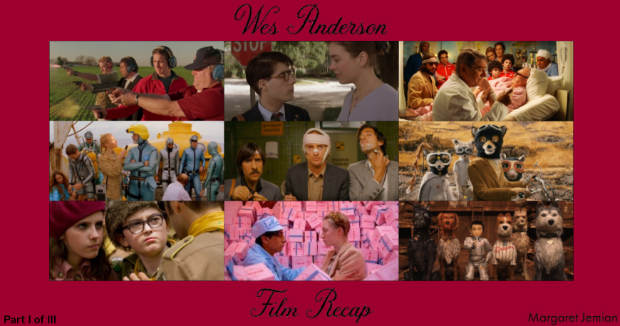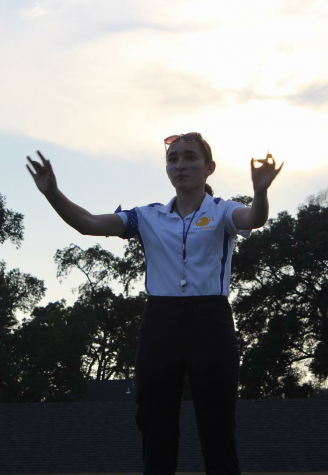Wes Anderson Film Recap
Part I
Please note that this is Part I of a three part series.
May 8, 2020

The following is a piece submitted by junior Margaret Jemian, who is the Junior Drum Major of the 2019-20 Lake Forest High School Band and is commonly known as “your friendly neighborhood movie buff.” Want to contribute to TFS yourself? Send an op-ed to [email protected].
Ever since I was a kid, my love for film has ruled my life. From Casablanca to Parasite, the study of movies has grasped my attention. Anyone who knows me would say that I am obsessed, and that is why I made a goal for myself last June. Back in 2017, my sister had been intrigued by a movie entitled The Grand Budapest Hotel, written and directed by Wes Anderson, a filmmaker who was notorious for his distinctly unique style.
So, last summer, I took on the challenge of watching all of Anderson’s nine feature-length films, diving straight into a realm of imaginative storylines and idiosyncratic characters. I have learned so much from his films, and I hope that you will get a sense of Anderson’s style based on what I have to say.
Disclaimer: as a cinephile, I hate it when people spoil movies, so for all you movie fans who agree with me, you’re in luck. No spoilers ahead! Please enjoy.
Bottle Rocket (1996)
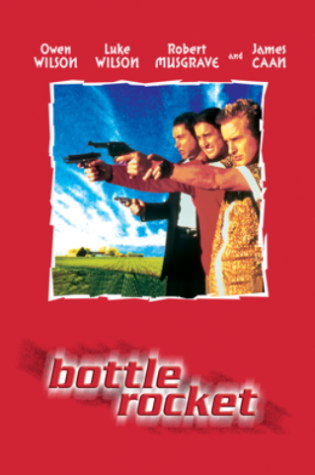
Synopsis:
This engaging yet laid back film follows the story of three friends who plan to pull off a simple crime, go on the run, and then lay low. However, this plan is compromised when a larger heist commences and the protagonists run into some trouble. Starring Luke and Owen Wilson, this is the first of Wes Anderson’s nine feature-length films to come.
Review:
To be quite frank, many of Anderson’s well notarized style tactics are more prominent in his next film, Rushmore, and grow in intensity as he himself grows as a filmmaker. Bottle Rocket does not seem to fit within his filmography due to its lack of stylistic peculiarities, unlike his later films.
Anderson attended the University of Texas at Austin, which is where he met Owen Wilson, with whom he wrote this film. Despite graduating with a degree in philosophy, Anderson managed to craft a black and white short called Bottle Rocket, casting the two Wilson brothers as the bizarre best friend duo that the story plays around, adding a more realistic flair to their character’s on-screen relationship.
That short was released as a feature-length color film (bearing the same name, of course) three years later, featuring the Wilson brothers (all three siblings appear in the film), Kumar Pallana, an actor who will be in almost every single Anderson film until his death in 2013, and even James Caan, who is notable for his role as Sonny Corleone in The Godfather.
While they appear to be on a minor scale, many of the special techniques and details that characterize Anderson’s style, such as dialogue ticks and camera movements, are delicately reflected in this film, even though these unique and specified mannerisms are in their earliest stages. No matter how oddly normal this film is compared to his other works, this will always be Anderson’s first film, and those differences will be the thing that sets it apart from the others. A film at the start of a filmmaker’s career can show growth when looking at their most recent productions, and when turning back to Bottle Rocket, the growth is so incredibly visible.
Rushmore (1998)
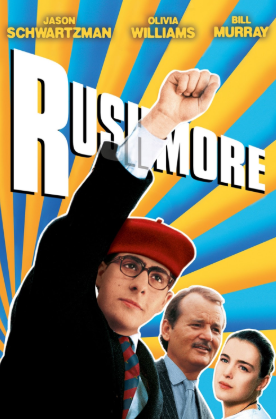
Synopsis:
Fifteen year old extracurricular king of Rushmore Academy, Max Fisher (Jason Schwartzman), and his older, more successful mentor, Herman Blume (Bill Murray), are both in love with the same teacher (Olivia Williams) and will do anything to get her attention (even act like children in the process).
Review:
The comedy within Rushmore follows a relatively unconventional style. This film, similar to Bottle Rocket, was written by Anderson and Owen Wilson, which provides an explanation for the similar style of humor between the films. While I personally did not find this movie incredibly comical, there are a few embedded quirks that did crack me up. Many of the one-liners and character names are very witty, which does keep the viewer entertained.
Schwartzman was at the spry young age of eighteen upon the film’s release, actually shooting the film at Anderson’s former high school. One thing that I particularly liked about this film is the eventually-recurring thematic element in Anderson’s works of children acting like adults and adults acting like children, in conjunction with the portrayal of a ‘man-child.’ This concept provides a slight comedic turn on an otherwise dramatic or serious plotline.
Max’s inability to move on from the school and become an adult in the world is consumed by the false perception of his growth in life — attempting to act like a mature adult when in reality he is nothing but a mere fifteen year old student spread too thin in extracurriculars to do well at the academy and graduate.
While he is a talented playwright, this pseudo-maturity ingrained in his mind doesn’t allow him to both take criticism well and reveal what he views as his ‘familial flaws’ to others. Accordingly, he draws close to Herman Blume, whose grand success he admires and aspires to replicate in his own life, however, as mentioned above, when they both fall for the same teacher, Blume dawns juvenile actions to, in a fit of jealous rage, get back at Max. The child-like brawls between the two result in nothing more than what they started with, getting the pair absolutely nowhere.
Rushmore is both technically miraculous and enjoyable for many. While this film wasn’t quite for me (even though the study of it has definitely piqued my interest), I invite you to check it out, as it truly is a unique film!
The Royal Tenenbaums (2001)
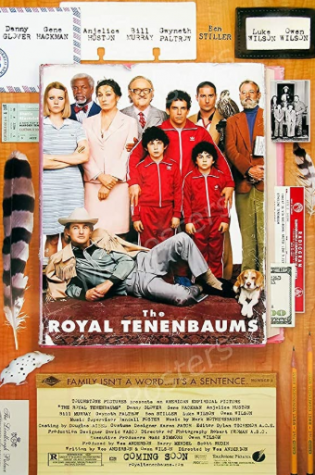
Synopsis:
The Tenenbaums were never an ordinary family, as all three of the children wildly excelled in their respective studies: Richie Tenenbaum was an all-star tennis player, Chaz Tenenbaum succeeded in the business world, and Margot Tenenbaum was an award-winning playwright. Unfortunately, as time has passed, the family has split and gone their separate ways. Far into their adulthood, this dysfunctional family reunites with the help of their father, Royal Tenenbaum (Gene Hackman), no matter how they feel about each other.
Review:
The first of Anderson’s films to be nominated for an Academy Award (Best Original Screenplay), this movie most definitely brought forth the quirky and creative filmmaking that we now know and love. Within its unique storyline, Anderson’s integration of material synecdoche (the symbolic or metaphorical use of objects, specifically clothing in this film) truly enhanced the depth of some of his characters.
All three of the child geniuses continue to reflect their, what I call, ‘lack of loss of innocence’ into their adulthood via their clothing. The unchanged looks of the siblings represent their static familial issues that they have and will always carry on their backs, constantly affecting their thoughts, actions, demeanor, and general character.
This is witnessed through Richie’s tennis headband, custom wrist sweatbands, and dark sunglasses, seemingly an homage to his glory days on the tennis court. Chaz and his son’s sport matching Adidas tracksuits, reflecting his controlling grip over his sons and his childlike instinct to prevent every horrible outcome of any situation, never having moved past the tragic death of his wife. Finally, Margot, like her brothers, has worn the same outfit her entire life. Her modest fur coat, polo dress, dark eyeliner, and Birkin bag express the contradiction she embodies, being a rebellious person, having smoked since the age of twelve and constantly living in sexual promiscuity, yet dressing in more conservative pieces and always keeping to herself.
The clothing they wear reflects all of their histories, unforgotten losses (in tennis and life), and overall contradictions. However, when looking at all of the emotional baggage the siblings bear, everything draws back to their father, Royal. He, as portrayed in the film, was not the best father he could have been, instead, their mother, Etheline Tenenbaum, posed as their main cheerleader, constantly supporting the trio through their success. I would say that the lack of a good, responsible father figure in the Tenenbaum household led to the crumbling of the family and all of the downfalls of the children.
That is about as much as I can say without revealing key parts of the film, but I hope what I’ve said gets you thinking! Overall, this film is creative, witty, entertaining, disturbing (in a gentle way), but mainly a grand piece to the puzzle that is Anderson’s filmmaking.

